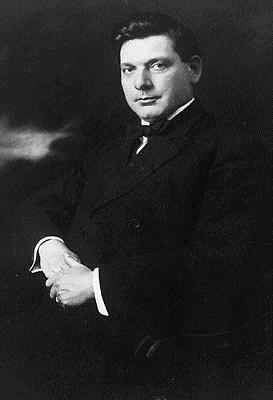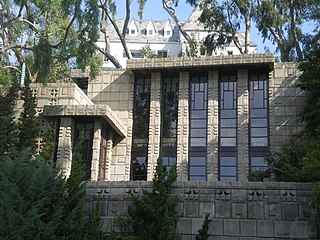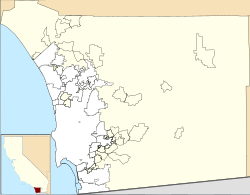
The Spanish Colonial Revival style is an architectural stylistic movement arising in the early 20th century based on the Spanish colonial architecture of the Spanish colonization of the Americas.

Bernard Ralph Maybeck was an American architect in the Arts and Crafts Movement of the early 20th century. He was an instructor at University of California, Berkeley. Most of his major buildings were in the San Francisco Bay Area.

The Lovell House or Lovell Health House is an International style modernist residence designed and built by Richard Neutra between 1927 and 1929. The home, located at 4616 Dundee Drive in the Los Feliz neighborhood of Los Angeles, California, was built for the physician and naturopath Philip Lovell. It is considered a major monument in architectural history, and was a turning point in Neutra's career.

Irving John Gill, was an American architect, known professionally as Irving J. Gill. He did most of his work in Southern California, especially in San Diego and Los Angeles. He is considered a pioneer of the modern movement in architecture. Twelve of his buildings throughout Southern California are listed on the National Register of Historic Places, and many others are designated as historic by local governments.

Ellen Browning Scripps was an American journalist and philanthropist who was the founding donor of several major institutions in Southern California. She and her half-brother E. W. Scripps created the E. W. Scripps Company, America's largest chain of newspapers and patron of the Scripps National Spelling Bee, linking Midwestern industrial cities with booming towns in the West. By the 1920s, Ellen Browning Scripps was worth an estimated $30 million, most of which she gave away.

The Woman's Club of Palmetto is a women's club and is also the name of its historic building in Palmetto, Florida. It is located at 910 Sixth Street West. The building was added to the National Register of Historic Places in March 1986.

Horatio West Court, built in Santa Monica, California in 1919, is an early example of attached houses with shared pedestrian and vehicle access. The six little buildings are grouped on a 60-foot lot. It was designed by Irving Gill.

Storer House is a Frank Lloyd Wright house in the Hollywood Hills of Los Angeles built in 1923. The structure is noteworthy as one of the four Mayan Revival style textile-block houses built by Wright in the Los Angeles area from 1922 to 1924.

The Old Scripps Building is a historic research facility on the campus of the University of California, San Diego in La Jolla, California. Built in 1909-10, it is the oldest oceanographic research building in continuous use in the United States and the historic center of the Scripps Institution of Oceanography. It is also architecturally significant as a work of Modernist architect Irving Gill and for its early use of reinforced concrete. It was declared a National Historic Landmark in 1982. It now houses Scripps administrative offices.

The Walter L. Dodge House in West Hollywood, California, was an architecturally significant home, designed by Irving Gill in the Early Modern style. Though the Dodge House received significant recognition from architectural experts, it was targeted for redevelopment. A long preservation effort to shield it from the wrecking ball ultimately failed, ending with complete demolition in 1970. The Dodge House was replaced by apartments.

The Primera Iglesia Metodista Unida de Ponce was the first structure erected in Puerto Rico by the celebrated architect Antonin Nechodoma. Constructed in 1907, the building houses a Methodist congregation and is located on Villa street in Ponce, Puerto Rico, in the city's historic district. The structure was listed on the U.S. National Register of Historic Places on 29 October 1987.

Lilian Jeannette Rice was an eco-conscious, early 20th-century American architect working primarily in the California Spanish Colonial Revival style. Several of her works are listed on the U.S. National Register of Historic Places under spelling variation Lilian Jenette Rice.
The La Jolla Historical Society is a private 501(c)(3) nonprofit organization in the La Jolla community within San Diego, California. According to its mission statement, it "celebrates the history and culture of this region along the water's edge through interdisciplinary programs, exhibitions, and research that challenge expectations. It balances contemporary and historic perspectives to create understanding and connection."

The Mission Revival style was part of an architectural movement, beginning in the late 19th century, for the revival and reinterpretation of American colonial styles. Mission Revival drew inspiration from the late 18th and early 19th century Spanish missions in California. It is sometimes termed California Mission Revival, particularly when used elsewhere, such as in New Mexico and Texas which have their own unique regional architectural styles. In Australia, the style is known as Spanish Mission.

The Wauwatosa Woman's Club Clubhouse is located in Wauwatosa, Wisconsin. It was added to the National Register of Historic Places in 1998.
Alberto Owen Treganza, sometimes known as Albert Treganza or A.O. Treganza, was an American architect and ornithologist in the early 20th century.

The California Quadrangle, California Building, and California Tower are historic structures located in Balboa Park in San Diego, California. They were built for the 1915–16 Panama-California Exposition and served as the grand entry to the Expo. The buildings and courtyard were designed by architect Bertram Goodhue. They were added to the National Register of Historic Places on May 17, 1974. They now house the Museum of Us.

Louis John Gill was a San Diego-based architect and the nephew and one-time business partner of another famous San Diego architect, Irving Gill. The San Diego Historical Society calls Louis Gill "one of San Diego's greatest architects".

The Silver City Woman's Club is a historic women's club located at 411 Silver Heights Boulevard in Silver City, New Mexico. The club was founded in 1909, and it built its meeting house in 1935–36. Richard Tatsch designed the clubhouse in the Pueblo Revival style, which reflected the region's architectural history. The clubhouse provided two spaces for the club's community activities and private meetings; the former included distributing food to needy families and conducting child welfare inspections on behalf of the state, while the latter included self-improvement courses in music and literature. The women's club has continuously held its activities in the building since its construction; it has also provided a space for community meetings and large events.

The Woman's Improvement Club Clubhouse in Corona, California, at 1101 S. Main St., was built in 1913. It was listed on the National Register of Historic Places in 1988.






















